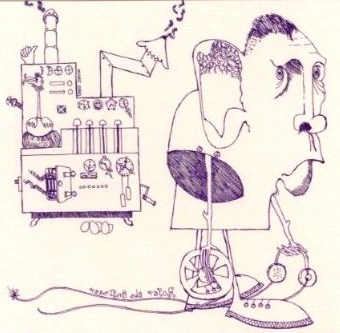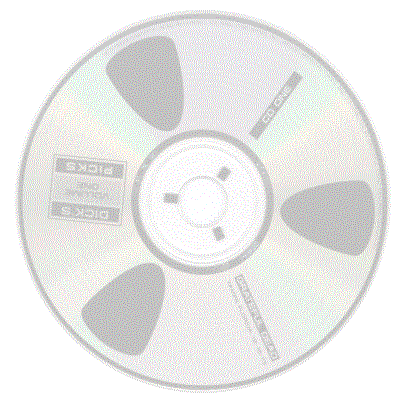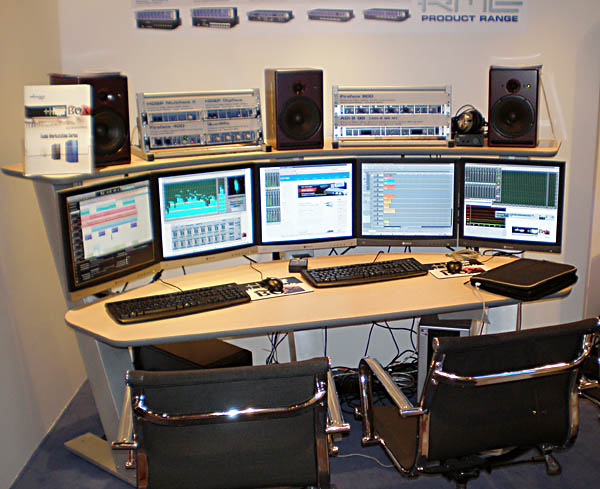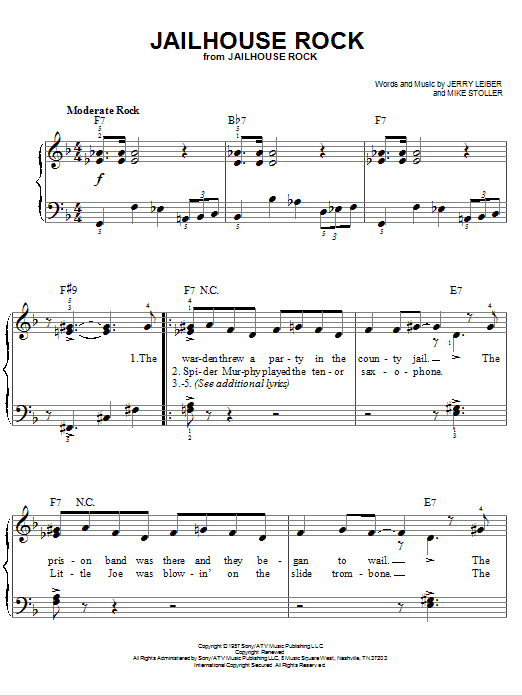Record- & Music Production
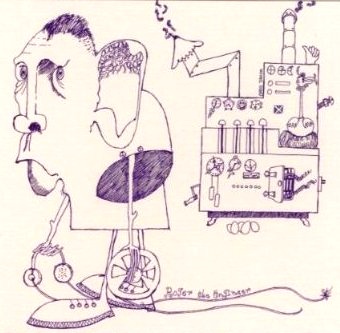
Roger the Engineer from The Yardbirds LP by the same name.
Drawing by Chris Dreja.
In the series about rock music hardware, we take a look at record- & music production.
Technical and musical greetings from
Kurt Starlit
- aka CykelKurt
CykelKurt
This series includes:
Latest update: 2016.April.10
===================================================
The lacquer record
The first record came on the market around 1900. It was made of asbestos and shellac, and for this reason called a lacquer record. The rotating speed of a lacquer record was 78 revolutions per minute. The playback time of a laquer record was less than five minutes.
In the beginning, when electricity was rare, recording was done by using a horn, concentrating the sound in one point. Here, the cutting needle was located, cutting a groove in the record. For this reason, the groove was a copy of the sound (speech, music or whatever) that was leaded into the horn.
The sound quality was poor, so around 1928, studios switched to electric recording, using a microphone.
The lathe (cutting machine) were usually located in the very studio together with the musicians. In this way, the recording was done while the musicians were playing. A cutting engineer was reading the notes while the score proceeded, adjusting the distance between the grooves according to the loudness of each passage.
A shellac recording from 1925
A shellac record had a maximum playing time of 5 minutes per side of a 10" (25 cm) record. On the larger records with a diameter of 12" (30 cm), the playing time were approx. 10 minutes.
The vinyl record
After World War II, the first vinyl records are launched to the US market. They rotate at 45 revolutions per minute and has a diameter of 7" (18 cm).
For optimal exploitation of (limited) space, the bass is decreased during recording (and increased again during playback).
In this way, the grooves can be located closer to each other, making room for longer playing time (compared to the laquer record).
For this reason, the vinyl record is smaller, yet performing the same (or more) playing time than the lacquer record.
The English term "single" is used also in Denmark, where a 7" record is called a "single", because it has got room for just one song/tune.
The single record is gradually launched to the Danish market up through the 1950s (personally, I bought my first single record with Jorgen Ingmann in 1958).
The slightly larger EP-record (10" - 25 cm) is launched in late 1950s (EP = Extended Play). The EP contains two numbers on each side.
In Denmark, the last lacquer records are released in 1958. From this point, every record is made of vinyl.
The LP record
The LP record measuring 12" (30 cm) is launched simultaneously with the single record. It is made of vinyl, and rotates at a speed of 33⅓ r.p.m. LP is an abbrevation meaning Long Playing.
The LP record for the first time makes it possible to store and play back a full hour of sound on one record.
In 1960, most record companies are launching their recordings in stereo. So, in the years to come, the consumer has the option to choose whether a record should be in mono or stereo.
In the 1970s, there is a lot of experimentation with 4-channel stereo - the so-called quadrophonic sound. But alas, it never worked really well, and besides the companies never agreed on single quad system, so, by the end of the decade, quadraphonic sound disappeared into oblivion.
In the 1975-85 period, the LP is experiencing a brief renaissance, as a few (small) independent record companies re-launches the so-called Direct to Disc record. The idea is, that the record in principle is made like in the good old days of shellac recording. It is also called at "direct cut" LP/record.
What this mens is, that all musicians, the cutting lathe and the cutting engineer need to be present at the same time in the same studio. An entire recording (one side of an LP) is done in one workflow. No breaks are permitted when recording!
All sails are set to make the recording perfect, e.g. virgin vinyl is used consequently when pressing the bisquit.
So, everybody should be happy now.....or....??
Yeah, well, that's a good question....at least it can be said, that the party was over with the arrival of the CD.
On the CD there is absolutely no hiss or background noise. Furthermore, the CD measures only 4.7" (12 cm), making it a lot easier to handle than the LP.
Vinyl production
The production of a vinyl record is a complicated process, wich is explained in the following two links below.
How Vinyl Records Are Made, Part 1
The process, briefly explained:
1. You start with a circular aluminum plate, which is light and stiff.
2. The aluminum plate is painted. It is now called a laquer disc.
3. In the laboratory, the laquer disc is placed on the lathe (the cutting machine).
4. The sapphire-tip-cutter etches the sound into the surface of the disc
in accordance with the music that was recorded.
From start to finish, the recording will be one continuos groove.
5. The record is now called a "master disc".
How Vinyl Records Are Made, Part 2
6. The master disc is sprayed with tin chloride and liquid silver,
so it can cope with the subsequent nickel coating.
7. The master disc is coated with a heavy layer of nickel,
to make the record stiff and strong.
8. The metal disc (silver and nickel) is separated from the laquer disc, which is discarded. This metal layer is called a "stamper", as it will be used to press vinyl records.
9. The stamper is the new master record
as it works like one side af the final record,
when the record is to be stamped.
10. The two stampers (= the final record front & flipside) are mounted in a press
with a lump of poly-vinyl-chloride (a so-called "bisquit") between.
11. With a pressure of 100 tons at a temperature of 193° celsius,
the bisquit is melted and moulded into the final record.
12. The record is subjected into a cooling cycle that hardens it.
13. The record is now ready to be put into a record sleeve and a cover.
A particular problem when etching a record is, how do you get room for two channels (left & right) in one groove?
This is explained here.
===================================================
CD - Compact Disc
The CD is launched in 1983 as a replacement for vinyl records. Physically, it is considerably smaller than an LP: 12 cm. Yet, it has got space for much more music: 650 MB = one hour of playing time. And not to be forotten: In a much better quality.
Unlike the vinyl record, where all sounds are stored in an analogue form on the record, all sounds on a CD are digitized, meaning that the sounds are converted into codes of 0 and 1. This is done through an AD Converter - Analogue to Digital Converter.
The analogue signal ("the sound") is converted by sampling (measuring) the analogue signal roughly forty thousand times per second (exactly 44,100 samples per. second). Each sample can be understood as a sound recording, lasting 40 thousands of a second (= 25 microseconds).
Each sample (recording) is converted into a 16-bit (= 16 digits) digital number in the AD Converter. E.g. "0011001001111000" is a 16-bit digital number (= code = sample = recording).
A 16-bit digital number consists of 16 digits, each with a value of 0 or 1. A 16-bit code could, for example, look like this: "0100101001110110". The 16 digits describe or contain one measurement (= one sample = one recording).
These samples (measurements) are measured forty thousand times per second to convert an analogue signal into a digital number or code.
A 16-bit digital number consists of 16 digits, each of which has a value of 0 or 1. A 16-bit number, for example, could look like this: "0100101001110110".
The 16 bits (or digits) represents one measurement (one sample) and, as stated, these measurements are carried out 43,100 times per second.
The purpose: to convert an analogue signal ("sound") into a digital number or signal.
Read more about binary numbers HERE.
The more measurements (samples) that are carried out, the higher quality of the final sound you'll get.
In short, you have to make twice as many samples as the highest note requested to be converted. Is the highest tone for example 20,000 Hz, you'll have to carry out (or measure) 40,000 samples out per second.
Physically, on the CD itself, "0" and "1" are made by etching a small hole in the CD every time you want to write a "0". "No hole" is understood as "1". Each hole is, of course, very small. We are talking about a few few thousandths of a millimeter.
Millions and millions of samples have to be etched down into the CD, before it is ready to be listened to.
If we, for example, assume that a musical piece lasts 40 minutes, we need to carry out
40.000 samples (per second) x 2 (channels) x 60 (seconds) x 40 (minutes) = 192.000.000 samples (measurements).
In other words: A 40 minute stereo recording contains roughly speaking 200 million samples (each sample consisting of a 16 bit recording/measurement) on one CD.
When etching the CD is done, the record is covered with a lacquer.
In principle, the CD is now ready to be placed on the CD player.
ANALOG
is Greek analogos, meaning "the same" or "similar".
For this reason, analog electronics are electronics "the same as" or "similar to" something.
For example, the groove of a phonographic record is "similar to" a piece of music.
..........
DIGITAL
comes from Latin digitus, meaning "described with numbers".
Digital electronics therefore means electronics "described with numbers".
ref.: Binary number
When a CD is to be played, it is done by means of a digital turntable - a CD player.
The CD player reads the holes on the CD by means of a LASER (Light Amplification by Stimulated Emission of Radiation). The laser emits a very thin light beam, which, at an incredible speed, detects either a "0" or a "1" from the CD surface. This detection is carried out more than half a million times per second.
In this way, the millions of holes are restored into a digital code (or number).
The digital codes are fed to a DA Converter (digital to analog converter), which converts the digital signal/code/number into the original analog (sound)signal.
Finally, the analog signal is fed to the output stage of the CD player.
===================================================
LP vs. CD
The LP had its heyday in the 1960s and 70s. In the 1980s, the CD came on the market and gradually took over. Still, there are people who swear faithfulness to the vinyl LP. In December 2014, on Facebook you had the opportunity to enjoy the following discussion.
Kurt Starlit
"Produce your own vinyl records at home on the desktop", I recently read in a newspaper, and "The LP has returned ", someone told us.
And although I'm not attacted to the idea of disappointing enthusiastic LP lovers, because out of a sheer aesthetic or nostalgic point of view, the LP record certainly has its right to stay here, but technically the LP is.....let's say limited.
Even the best LPs - those who were originally launched as "direct cut" (meaning etched in virgin vinyl on the best machines in the studio, while the musicians are playing) have a signal/noise ratio (= the distance from residual noise up to the audio signal) which is far below the CD.
The dynamics (= the distance from the faintest to the loudest sound) is also far below the CD.
The wear of the LP when playing, is considerably, where the CD can be played infinitely without any wear.
Distortion is several times higher on an LP, compared to a CD.
But allright, it may be that - just like old cars have become fashionable - it has become fashionable to collect vinyl. But from a technical point of view, there is no comparison whatsoever.
Peter Krog
Sound quality can probably never be better than the weakest link in the chain - except if you use compressors etc.
Kurt Starlit
Compressors - oh boy, if you knew how many recordings that are heavily compressed, because there are too little room for bass and dynamics on a vinyl record. You'd probably be ready for communion, sending a prayer to Saint Peter, if you really knew.
In my younger days, there was an endless preaching for us radio mechanic apprentices, how many compromises you have to make, when recording vinyl.....you get quite discouraged to think about it.
Talking 'bout "the weakest link" as you do, I'd rather suggest the weakest link to be the dynamic loudspeaker. Just like the LP, it is a completely compromised product. It's close to impossible to tell all the compromises the manufacturers of dynamic speakers (which approx. represent 90% of all speakers) have to deal with.
Why Vinyl Sounds Better Than CD, Or Not
Henning Nor
Vinyl is nostalgia, approved by many a "feinschmecker", claiming that vinyl is the only way.
Talking about the best sound, I agree on your judge, Kurt, vinyl don't stand a chance, compared to CD.
Kurt Starlit
Most elderly people probably have sweet memories of their lovely vinyl records.
The peak of my vinyl life (if you could call it so), was the mid-1970s, where a small undergrowth of enthusiast companies emerged. They recorded and issued the so-called "direct cut" LPs.
For these records, all sails were set, to make the experience perfect. However the sweet sound had a price: A direct cut LP was priced around 30 dollars.
My favourite vinyl record was Thelma Houston with a big band that recording each side of an album in one workflow. The was a recording engineer present in the studie during the recording, adjusting groove distance manually while the analog audio signal was etched into the laquer record.
Between songs/numbers, you could hear musicians breathing while flipping pages on to the next song or number.
Really, this was live recording in the studio!
When such a record was played back on a reasonable sound system - my system consisted of
- an ERA turntable with SME arm,
- an Ortofon low impedance pick-up with step-up transformer,
- a NAD 2 x 100W amplifier plus
- two 15" Cerwin Vega speakers
mounted with midrange & tweeter drivers
in a 300 litres rear-loaded horn cabinet
(bought from a rock group, who had given up these monsters)
- then there wasn't much to complain about.
Maybe I should mention the noise generated by the needle, when it was "ploughing" through the grooves of a record.
I tried to fight this phenomenon by systemtically cleaning record & pick-up in "demoralized" water AND using two DBX units to improve the signal/noise ratio.
This they did resonable..... well, this was all before the CD came out of the closet. The CD changed everything.
Anyway, for the sake of old acquaintance, let's one more time listen to juicy Selma Huston & her skilled musicians making it all groovy:
Thelma Houston 1975, full album
Kurt Starlit
Maybe it should be explained that the Thelma Houston record was never recorded on tape.
It is stated clearly on the record cover:
This is a direct cut LP, recorded live in the studio.
No tape recorder, just a mixer and a lathe.
Afterwards, a limited number of records were produced - each one with a serial number.
The recording presented here is recorded FROM a direct cut record TO a digital media.
===================================================
The recording studio
The first studios
To describe a recording studio in the years up to approximately 1950 is a piece of cake. It consisted mainly of a microphone and a lathe. Later, the tape recorder, mixer and reverb unit gradually became a part of a well-equiped studio.
A recording studio of the 1960s was also rather primitive: A few microphones, a small mixer (3-6 channels) and a monaural tape recorder. For example, The Beatles "Sgt. Peppers" was recorded on a 4-track recorder. We are well into the 1970s before the Multi-track recorder and mixer becomes common.
Adding reverb to a recording was up to 1970 done by doing the recording in a room or hall with the right amount of natural reverb; cinemas and concert halls could be examples of this.
Why a studio?
In an anarchic moment one maybe might ask: Why do we need a studio at all - couldn't we just do the recording where we are right now?
And the answer is, YES we could, BUT certainly and inevitably a number of obstacles would emerge, that would have been avoided if we had used an isolated recording studio.
If you do the recording where you more or less randomly are located, you will most likely be bothered by passing cars, footsteps on the stairs, barking dogs, slamming doors, yelling and screaming and who knows what.
That kind of problems have been solved in an isolated studio.
Moreover, any recording in any room will be affected by the atmosphere or reverberation of that particular room.
In an isolated studio, you create your own personal sound and/or acoustics by means of (physical) isolation, reverberation and furnishings.
Therefore, for your information::
A recording studio is a room which is acoustically isolated from the surroundings,
in such a way that recording can be done without disturbance from the environment.
A studio basically consists of a control room (where the recording equipment and technicians are located)
and a recording room (where musicians, instruments and microphones are located).
The recording room should have variable acoustics (reverberation),
regulated by means of acoustic panels and other damping material.
The electrical equipment of a studio can vary, depending on personal taste and budget.
You could, as an example, choose a multi-track tape recorder OR an ordinary stationary computer (PC)
with an image editing program (e.g. Cubase, Logic or Pro Tools,
or you could choose a workstation or a harddisk recorder.
The mixer desk is a central tool in the studio. It is used for, as an example,
- recording instruments and voices,
- mixing instruments and voices with each other plus
- producing demo tapes, master tapes, banners and much more.
Monitors - speakers to check what's recorded - are absolutely essential.
Headphones for musicians and technicians is a must.
In addition, you'll need a lot of accessories like
microphones (a dynamic type like Shure SM 57 can handle the most),
equalizer, compressor, expander, flanger, phaser and chorus.
Studio- vs. domestic tape recorder
In a modern studio, the tape recorder is long gone. Probably it has been replaced by a harddisk drive, or maybe the studio has switched to a workstation, covering nearly all needs of a contemporary studio.
There's a big difference between a domestic tape recorder and the multi-track machines, which were previously used in most recording studios.
The domestic tape recorder
The domestic tape recorder was an all-in-one machine with everything needed for mixing, recording and playback. Moreover, it shouldn't be too expensive.
Needless to say, a lot of compromises had to be made. One compromise is one motor, doing all the hard work. Compared to this, the professional studio tape recorder has got at least three motors - each doing what they are best at.
Norwegian TANDBERG did their best by producing a working all-in-one domestic tape recorder, model 62X.
The TANDBERG 62X was launched as a "Sound-on-Sound" recording macine, meaning that you (the musician) play back and forth between the two tracks - one track is playing back, while the other track is recording.
Simultaneously with recording, you mix a new voice (or instrument) on top of what is alredy recorded. In this way, you record (create) a new voice (or instrument) on each overdub.
Finally you end up with a one-man orchestra, where you have played (or sung) all voices.
BUT (because there is a BUT):
These overdubs has a cost in sound quality. More than four or five overdubs are not realistic. So, even if a home recording may have charm and personality, it will never technically threaten what is recorded in a professional studio.
The tape speed (the speed at which the tape is advanced) is for most amateur tape recorders no more than 19 cm/sec. - most often only the half: 9.5 cm/sec. or even 4.75 cm/sec. And the result is correspondingly.
Tape speed
76 cm
30"
38 cm
15"
19 cm
7½"
9.5 cm
3¾"
4.75 cm
1⅞"
The studio tape recorder
The studio tape recorder is running at 38 cm/sec. as standard - often at 76 cm/sec. as well. The tape speed affects the dynamics and signal/noise ratio to a high degree.
Furthermore, the studio tape recorder will record or playback any track, according to your command.
However, it is completely dependent on an external mixer, which is decisive for, how many tricks you can perform on a given tape machine.
Mastering
When the music is recorded, it is often located on a number of tracks (16, 24 or 48) on a so-called master tape. From this master tape, a copy is made where the many tracks are mixed down into one tape - a production master.
The Production Master is sent to a LP-producer, who uses it to produce a laquer record - and ultimately into a lot of vinyl records (read about vinyl recording further up).
Are we talking CD production, the process is basically the same, but in practice somewhat different - read e.g. this article on audio mastering.
Distribution
Once the music is recorded, and the record is ready, you probably want to deliver your miraculous product to the world. This is called distribution, to distribute a record.
Distribution is done from a distribution company, which in its turn has got a distribution network, i.e. a number of (retail) dealers who distribute (sell) the plate on to the customer.
These days, with the advent of the internet, a number of artists has begun to distribute their own records. To do this, the customer first must transfer a specified payment (via homebanking or otherwise), after which he is authorized to download the artist's music.
===================================================
DAW - Digital Audio Workstation (1980)
A digital workstation in 2012
DAW = Digital Audio Workstation
A digital workstation (or just workstation) is, in priciple, a mixture of a computer (hardware) and related software. In practical life, though, a workstation is often consisting of multiple computers with a number of applications and plug-ins.
Using a workstation, you can record, edit and mix audio (sounds). You could say that the DAW is a recording studio in miniature.
Back in the 1980s, when the DAW term was new, it was used to describe one system with one microprocessor. The system was primarily designed to play back sampled and synthetic sounds.
With the advent of better and faster computers, the DAW designation was extended to include software with multitrack sound facilities, plus audio and MIDI hardware interfaces as an integral part of the system.
The digital workstation is recording analog sounds by means of a sound card. The sounds are recorded for example through a microphone or through a line input. The sound card converts the analog audio signal into a digital signal, which is understood by the workstation, and therefore able to be processed.
If the sound signal is already digital, e.g. MIDI, you can use a MIDI interface to transmit the signal ("sound") to the workstation as well.
The workstation displays the audio signal on a screen, after which the processing of the signal ("the sound") can begin.
The idea of a workstation is, that you have all the necessary functions to produce a final sound product, assembled in one apparatus - i.e. in one program. For example, it could be:
- recording,
- producing,
- arranging,
- scoring,
- mixing and
- mastering.
In practice, the DAW can contain any combination of the above mentioned features (according to individual requirements).
Page one of a "Jailhouse Rock" score
Using a DAW, you can record a complete piece of music, AND do the scoring as well as the mastering, so it can be sent for a disc, CD or DVD producer, radio or TV-station etc.
Which DAW is right for your home studio?
The Recording Revolution
Recording and Production DAW Software Comparison
Today, many companies are offering workstations, but for clarificaton and explanation we stick to one of the best known:Cubase.
In the following 12 instructional videos for the Cubase 8 system, a number of important features are reveiwed:
Cubase 8, Chapter 1, Quick Start Video
Cubase 8, Chapter 2, Getting connected
Cubase 8, Chapter 3, Basic audio recording
Cubase 8, Chapter 4, Basic MIDI recording
Cubase 8, Chapter 5, Basic Mixing
Cubase 8, Chapter 6, Advanced audio recording and processing 1:2
Cubase 8, Chapter 7, Advanced audio recording and processing 2:2
Cubase 8, Chapter 8, Advanced production techniques 1:2
Cubase 8, Chapter 9, Advanced production techniques 2:2
Cubase 8, Chapter 10, Drums, mixing and export
Cubase 8, Chapter 11, Other workflows
Cubase 8, Chapter 12, Using automation and remote control devices
At Cubase, they are not reluctant to recommend themselves:
The users of our flagship DAW are among the most successful artists on the globe - from engineers recording and mixing rock albums to dance DJs, hip hop producers, songwriters creating pop hits or film composers scoring for Hollywood blockbusters. Cubase combines industry-leading sound quality, intuitive handling and a range of advanced audio and MIDI tools for composition, recording, editing and mixing.
Cubase (YouTube)
Steinberg Cubase (YouTube)
===================================================
The rock scene of the sixties:
This site is under constant consideration and expansion.
So, if you got an opinion on the topic in general or technical details in particular, don't hesitate to contact me:
Thank you very much!
Kurt Starlit
aka CykelKurt
